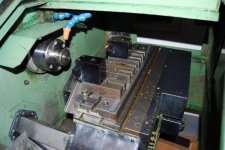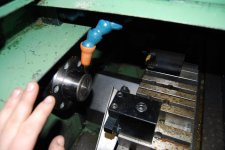Ok so here i am in the final parts of the gang tooled lathe build, literally got one more ball screw nut bracket to make and fundamentally mechanically im like 95% of the way there. Electrics im rapidly figuring out just what im doing but i have it covered.
Question is, what features if you have a choice do you want - need? Currently i have something like 16" of cross slide travel to load up with tooling, average part size is going to be say sub 2" diameter, but a varied range of bits, though all perfect gang tooled lathe parts. Im thinking with 2" parts i need tooling on circa 1 1/2" centres minimum to allow for some clearance. Straight shank ER collet chucks are dirt cheap, hence its probably what im going to go for in a simple tooling block, will make it easy if i get the longest ones i can to grip any typical, drill, tap or small boring bars i envision using whilst using there length to keep the gauge line reasonably constant? I currently have a mass of ER32 collets, but only a odd few ER25's, am kinda thinking i probably should be giving a lot more thought to ER16's or ER20's though? they would have enough capacity for most of the planned needs. But having so many ER32's im kinda wondering if i should stagger it er32-er 16-er32 etc, like this i can get tight centre distances - more tools in a given space whilst having a lot of options. equally 32mm bore holes spaced with smaller ones would open up a very wide range of boring bar options down the road. Would also make it effortless to have adaptor sleeves to use any of my existing and extensive 1" shank turret lathe tools.
Full threading, CSS and rigid tapping are going to be there, have all of those covered. Also am planning a proper MPG style hand wheel set-up. Is a tool probe a must? Or just a pain on a lathe like this, i know some people love em others hate em on turret lathes. Theres plenty of IO capacity for a range of coolant options too or pretty much any thing else i need control over, got a good 40+IO free and can easily add a lot lot more!
Currently there’s no plans for a C axis - live tooling, the parts im looking at doing whilst benefiting from this , just vary too much, as im kinda hoping 90%+ of the time to have this thing setup and just run any part with out changing too much tooling. Its going to be faster to just chuck them onto the mill than it is mess with masses of set-up time! Realistically this time next year im envisioning 100+ different parts programmed but probably only doing runs in the 10-50 of range of any given part every few months. Its about freeing me up and passing the work onto something automated + being able to machine very complex curvy parts. Its really not so much about being-able to drop finished parts in seconds, more about having a easier life! hence current thoughts are that anything much over 1/4" ID is going to simply be bored out, most parts threaded will be single pointed etc, all processes that let me avoid spending a hour or so swapping drills, taps etc. Equally quality taps in the thread pitch i need are bloody expensive, will be far cheaper to just thread em all single point style, even at the expense of some time (all 26tpi BSCY though so common pitch :-)
Any thoughts welcome!
Question is, what features if you have a choice do you want - need? Currently i have something like 16" of cross slide travel to load up with tooling, average part size is going to be say sub 2" diameter, but a varied range of bits, though all perfect gang tooled lathe parts. Im thinking with 2" parts i need tooling on circa 1 1/2" centres minimum to allow for some clearance. Straight shank ER collet chucks are dirt cheap, hence its probably what im going to go for in a simple tooling block, will make it easy if i get the longest ones i can to grip any typical, drill, tap or small boring bars i envision using whilst using there length to keep the gauge line reasonably constant? I currently have a mass of ER32 collets, but only a odd few ER25's, am kinda thinking i probably should be giving a lot more thought to ER16's or ER20's though? they would have enough capacity for most of the planned needs. But having so many ER32's im kinda wondering if i should stagger it er32-er 16-er32 etc, like this i can get tight centre distances - more tools in a given space whilst having a lot of options. equally 32mm bore holes spaced with smaller ones would open up a very wide range of boring bar options down the road. Would also make it effortless to have adaptor sleeves to use any of my existing and extensive 1" shank turret lathe tools.
Full threading, CSS and rigid tapping are going to be there, have all of those covered. Also am planning a proper MPG style hand wheel set-up. Is a tool probe a must? Or just a pain on a lathe like this, i know some people love em others hate em on turret lathes. Theres plenty of IO capacity for a range of coolant options too or pretty much any thing else i need control over, got a good 40+IO free and can easily add a lot lot more!
Currently there’s no plans for a C axis - live tooling, the parts im looking at doing whilst benefiting from this , just vary too much, as im kinda hoping 90%+ of the time to have this thing setup and just run any part with out changing too much tooling. Its going to be faster to just chuck them onto the mill than it is mess with masses of set-up time! Realistically this time next year im envisioning 100+ different parts programmed but probably only doing runs in the 10-50 of range of any given part every few months. Its about freeing me up and passing the work onto something automated + being able to machine very complex curvy parts. Its really not so much about being-able to drop finished parts in seconds, more about having a easier life! hence current thoughts are that anything much over 1/4" ID is going to simply be bored out, most parts threaded will be single pointed etc, all processes that let me avoid spending a hour or so swapping drills, taps etc. Equally quality taps in the thread pitch i need are bloody expensive, will be far cheaper to just thread em all single point style, even at the expense of some time (all 26tpi BSCY though so common pitch :-)
Any thoughts welcome!







